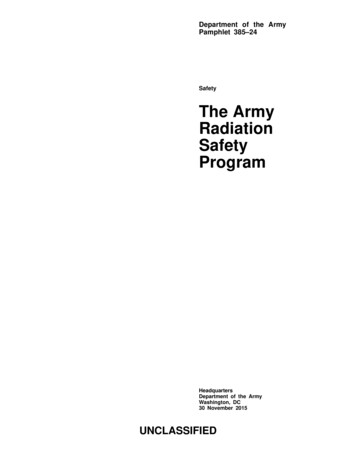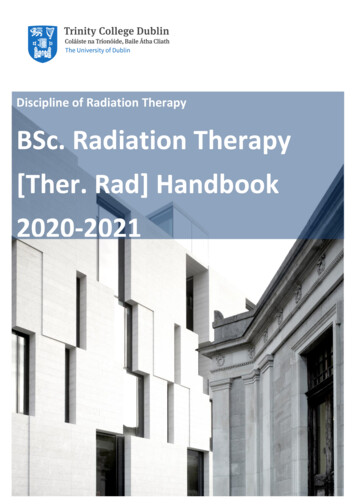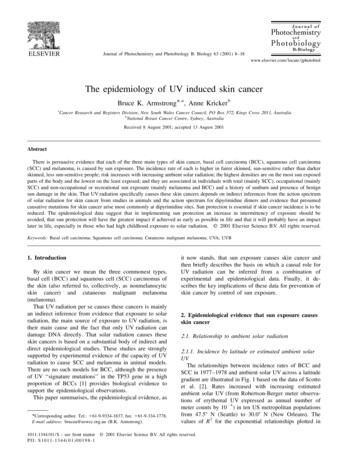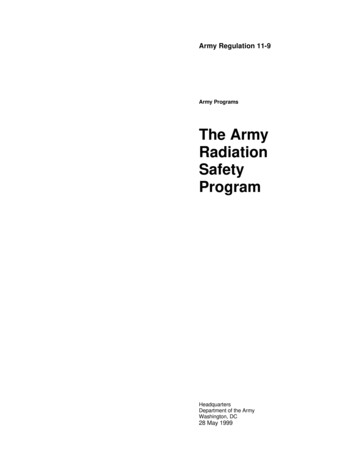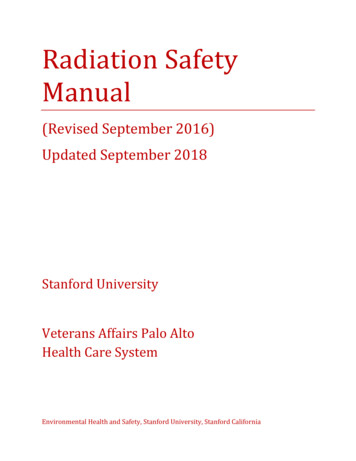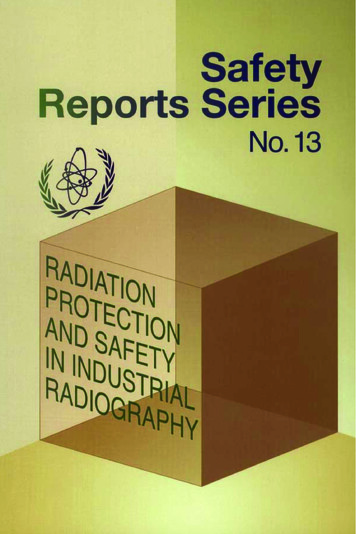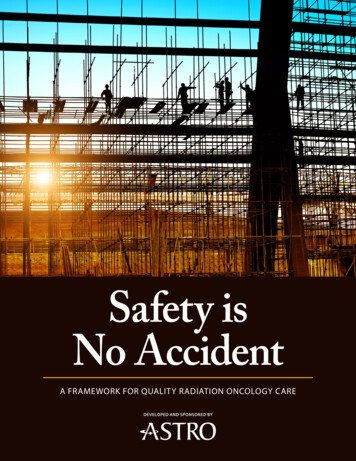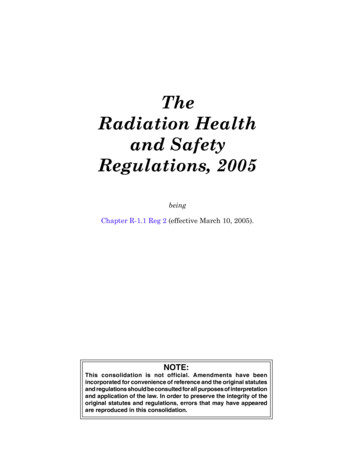
Transcription
1RADIATION HEALTH AND SAFETY, 2005R-1.1 REG 2TheRadiation Healthand SafetyRegulations, 2005beingChapter R-1.1 Reg 2 (effective March 10, 2005).NOTE:This consolidation is not official. Amendments have beenincorporated for convenience of reference and the original statutesand regulations should be consulted for all purposes of interpretationand application of the law. In order to preserve the integrity of theoriginal statutes and regulations, errors that may have appearedare reproduced in this consolidation.
2R-1.1 REG 2RADIATION HEALTH AND SAFETY, 2005Table of Contents3132333435DIVISION 4Ultrasound EquipmentStatement re medical ultrasound equipmentQualifications of operators – diagnosticQualifications of operators – therapeuticQuality assurance for ultrasound proceduresSafe use of ultrasound equipment3637DIVISION 5Radiofrequency RadiationRadio frequency radiation – exposure limitsMicrowave ovens3839404142PART IVIonizing and Non-ionizing RadiationDesign change notificationMaintenance schedulesAccident reportingAccidental radiation exposureRadiation warning signs4344454647484950PART VGeneralFurnishing statements, etc., to departmentRegistration feesFees for leak test analysisFees for radon measurementCalibration feesFees for consulting servicesInspection feesExamination fees5152PART VIRepeal and Coming into ForceR.R.S c.R-1.1 Reg 1 repealedComing into forcePART ITitle and Interpretation12TitleInterpretationPART IIIonizing Radiation345678910111213141516171819Dose limitsEffective dose calculationMonitoring of doseMonitoring procedureRecords of dosePregnancy of occupational workerMobile x-ray equipmentChange of useModifications to equipmentQualifications of operatorsSafety and preventive maintenance inspectionsFrequency of inspectionsCertification of equipmentQuality assuranceX-ray fluoroscopyDisplay of radiation hazard signRadiation hazard symbolPART IIINon-ionizing Radiation2021222324DIVISION 1Ultraviolet RadiationExposure limits to ultraviolet radiation – generalExposure limits to ultraviolet radiation –photosensitivityProtection where exposure limits cannot becomplied withCommercial tanning salons – safety featuresShields for tanning equipment25262728DIVISION 2Laser RadiationLaser classificationDuty to informExposure to class 3 or 4 lasersQualifications of operators2930DIVISION 3Laser Light ShowsStatement re laser light showsStandards for laser light showsAppendixPART ITable 1Table 2Table 3Table 4Table 5Table 6Table 7TablesRadiation Weighting FactorsOrgan or Tissue Weighting FactorsExposure Limits for Laser Light ShowsAnnual Registration Fee For Radiation EquipmentInstrument Calibration FeesEffective Dose LimitSpecific Equivalent Dose LimitsFigure 1PART IIRadiation Hazard SymbolPART IIIForm AForm BFormsRegistration of Laser Light Show InstallationRegistration of Medical Ultrasound Equipment
3RADIATION HEALTH AND SAFETY, 2005R-1.1 REG 2CHAPTER R-1.1 REG 2The Radiation Health and Safety Act, 1985PART ITitle and InterpretationTitle1 These regulations may be cited as The Radiation Health and SafetyRegulations, 2005.Interpretation2(1) In these regulations:(a) “absorbed dose”, with respect to any medium, means the ionizingradiation energy absorbed per unit mass, expressed in grays;(b) “Act” means The Radiation Health and Safety Act, 1985;(c) “approved”, with respect to equipment, means that:(i) the equipment meets:(A) a relevant Canadian standard acceptable to an officer; or(B) a standard that is prepared and publicly issued by thedepartment; or(ii) the equipment has been approved by an officer in writing on anindividual basis;(d) “chief occupational medical officer” means the person appointed asthe chief occupational medical officer pursuant to section 79 of The OccupationalHealth and Safety Act, 1993;(e) “chiropractic clinic” means a place in which radiation equipment isused by or under the direction of a chiropractor for diagnostic or therapeuticpurposes with respect to a patient;(f) “commercial tanning salon” means a tanning parlour, health spa, fitnesscentre, sports or recreational centre, beauty salon or any other establishmentthat is open to the public or to members of a club or association and in whicha person’s skin is deliberately exposed to ultraviolet radiation, but does notinclude any hospital or medical clinic where exposures to ultraviolet radiationare administered under medical supervision for therapeutic purposes;(g) “committed dose” means the equivalent dose received by any organ ortissue of the body of a person from the intake of any radioactive substance,other than radon or radon progeny, during the period of 50 years immediatelyfollowing the intake;
4R-1.1 REG 2RADIATION HEALTH AND SAFETY, 2005(h) “dental clinic” means a place in which radiation equipment is used byor under the direction of a dentist, as defined in The Dental Disciplines Act,for diagnostic or therapeutic purposes with respect to a patient;(i) “effective dose” means the sum of the products, in sieverts, obtainedby multiplying the equivalent dose of radiation received by and committed toeach organ or tissue set out in column 1 of Table 2 by the weighting factor setout in column 2 for that item;(j) “electromagnetic radiation” means energy in the form of electromagneticfields emitted from any source, and includes extremely low frequency radiation,radio frequency radiation, infrared radiation, visible light, ultraviolet radiation,x-rays and gamma rays;(k) “equivalent dose” means the product, in sieverts, obtained by multiplyingthe absorbed dose of radiation and the appropriate radiation weighting factorset out in Table 1;(l) “external source” means any source of ionizing radiation other thanradioactive isotopes that:(i) have been ingested or inhaled by an occupational worker; and(ii) are irradiating tissues from within the occupational worker’s body;(m) “extremely low frequency radiation” means electromagneticradiation in the frequency range below three kilohertz;(n) “five-year dosimetry period” means the period of five calendar yearsbeginning on January 1, 2001 and every period of five calendar years afterthat period;(o) “irradiance” means radiant power incident per unit area expressed inwatts per square metre;(p) “laser” means an optical source that emits coherent, monochromaticradiation from a solid state, gaseous or liquid lasing source;(q) “laser device” means a device that incorporates a laser;(r) “laser light show” means a form of entertainment that incorporates theuse of any laser or laser device;(s) “medical clinic” means a place, other than a hospital, dental clinicor a chiropractic clinic, in which radiation equipment is used for diagnosticor therapeutic purposes with respect to a patient, and includes a medicallaboratory within the meaning of The Medical Laboratory Licensing Act, 1994;(t) “medical ultrasound equipment” means ultrasound equipment thatis designed for use in a hospital, medical clinic or other place in carrying outdiagnostic or therapeutic procedures on patients;(u) “National Dose Registry” means the centralized record-keepingsystem containing the dose information of radiation workers in Canada thatis maintained by Health Canada;(v) “one-year dosimetry period” means the period of one calendar yearbeginning on January 1 of each year;
5RADIATION HEALTH AND SAFETY, 2005R-1.1 REG 2(w) “patient” means a person who is undergoing diagnosis or treatment byor under the direction of a health care professional;(x) “Radiation Safety Unit” means the Radiation Safety Unit of thedepartment;(y) “radio frequency radiation” means electromagnetic radiation in thefrequency range from three kilohertz to 300 gigahertz;(z) “radon progeny” means any of the radioactive decay products ofradon 222, namely bismuth 214, lead 214, polonium 214 and polonium 218;(aa) “ultrasound” means longitudinal pressure waves with frequenciesgreater than 15 kilohertz;(bb) “ultraviolet radiation” means electromagnetic radiation in thewavelength range from 100 nanometres to 400 nanometres;(cc) “veterinary clinic” means a place in which radiation equipment isused by or under the direction of a member, as defined in The VeterinariansAct, 1987, for diagnostic or therapeutic purposes with respect to an animal,as defined in The Veterinarians Act, 1987;(dd) “working level” means the unit of concentration of radon progeny in onecubic metre (1 m3) of air that has the potential alpha energy of 2.08 x 10‑5 joules;(ee) “working level month” means the exposure that results from theinhalation of air containing one working level for 170 hours and is theamount WLM, calculated in acordance with the following formula:1 WLM 3.54 mJh/m3where:mJ is millijoulesh is hoursm is metres.(2) In these regulations:(a) references to tables are references to the tables set out in Part I of theAppendix;(b) references to figures are references to the figures set out in Part II of theAppendix; and(c) references to forms are references to the forms set out in Part III of theAppendix.18 Mar 2005 cR-1.1 Reg 2 s2.
6R-1.1 REG 2RADIATION HEALTH AND SAFETY, 2005PART IIIonizing RadiationDose limits3(1) An owner of ionizing radiation equipment must ensure that the effective dosereceived by and committed to a person described in column 1 of Table 6 during aperiod set out in column 2 of that table is as low as is reasonably achievable witheconomic and social factors taken into consideration and does not exceed the effectivedose set out in column 3 of that Table.(2) If the effective dose received by an occupational worker in a one-year dosimetryperiod exceeds 20 millisieverts, the owner of ionizing radiation equipment mustsubmit to the Radiation Safety Unit a written report explaining in full thecircumstances in which the dose arose and summarizing the steps that will be takento minimize the possibility of similar doses arising in the future.(3) Every owner of ionizing radiation equipment must ensure that the equivalentdose received by and committed to an organ or tissue set out in column 1 of Table 7of a person described in column 2 of that item, during the period set out in column 3of that item, does not exceed the equivalent dose set out in column 4 of that item.18 Mar 2005 cR-1.1 Reg 2 s3.Effective dose calculation4(1) In this section:(a) “ALI”, as the acronym for annual limit on intake, means the activity, inbecquerels, of a radionuclide that will deliver an effective dose of 20 millisievertsduring the 50-year period after it is taken into the body of an adult or duringthe period beginning at intake and ending at age 70 after it is taken into thebody of a person less than 18 years of age;(b) “E” means the portion of the effective dose, in millisieverts:(i) received by a person from sources outside the body and includesx‑rays, Canadian Nuclear Safety Commission (CNSC) licensed activitiesor other sources of radiation arising from human activity; and(ii) received by and committed to the person from sources inside thebody, measured directly or from excreta;(c) “I” means the activity, in becquerels, of any radionuclide that is takeninto the body, excluding radon progeny and the activity of other radionuclidesaccounted for in the determination of E;(d) “Rn” means the average annual concentration in the air, in becquerels percubic metre (m3), of radon 222 that is attributable to a CNSC licensed activity;(e) “RnP” means the exposure to radon progeny in working level monthsthat is attributable to a CNSC licensed activity;(f) “ I/ALI” means the sum of the ratios of I to the corresponding ALI.
7RADIATION HEALTH AND SAFETY, 2005R-1.1 REG 2(2) For the purposes of item 1 of Table 6, the effective dose is the amount ED,expressed in millisieverts, calculated in accordance with the following formula:ED E 5 RnP 20 IALI(3) For the purposes of item 2 of Table 6, the effective dose is the amount ED,expressed in millisieverts, calculated in accordance with the following formula:ED E 20 IALI(4) For the purposes of item 3 of Table 6, the effective dose is the amount ED,expressed in millisieverts, calculated in accordance with either of the followingformulas:IRn;(a) ED E 20 ALI60(b) ED E 4 RnP 20 I.ALI18 Mar 2005 cR-1.1 Reg 2 s4.Monitoring of dose5(1) An owner of ionizing radiation equipment must ensure that the effectivedose and equivalent dose received by an occupational worker is systematicallydetermined.(2) An owner of ionizing radiation equipment must ensure that the dose of anoccupational worker determined by monitoring pursuant to subsection (1) is reportedto the National Dose Registry and to the Radiation Safety Unit not less than onceevery three months.(3) Subsection (2) does not apply to a dose of less than 0.25 millisieverts receivedby an occupational worker in a period of three months.(4) For the purpose of assessing compliance with the limits set by the Act andthese regulations, the current reading entered into the National Dose Registry withrespect to an occupational worker is deemed to be the actual dose received by theoccupational worker.(5) If, in the opinion of an officer, the circumstances warrant it, the officer mayrequire an owner to investigate the exposure of an occupational worker to ionizingradiation and report the results of the investigation to the Radiation Safety Unitwithout delay.18 Mar 2005 cR-1.1 Reg 2 s5.
8R-1.1 REG 2RADIATION HEALTH AND SAFETY, 2005Monitoring procedure6 If an occupational worker may receive an effective dose greater than 1 millisievertin a one-year period, the owner of the ionizing radiation equipment must arrange fora thermoluminescent dosimeter to be issued by a dosimetry service provider licensedpursuant to the Regulatory Standard S-106 (E), Technical and Quality AssuranceStandards for Dosimetry Services in Canada, A Joint Federal-Provincial Standardpublished by the Atomic Energy Control Board, March 20, 1998.18 Mar 2005 cR-1.1 Reg 2 s6.Records of dose7(1) An owner or operator who employs occupational workers or who is in chargeof training occupational workers must maintain a separate cumulative record on acontinuous permanent basis for each worker showing:(a) all measurements pertaining to the actual dose received, both externallyand internally, by the worker for the current one-year and five-year dosimetryperiods; and(b) the committed doses received from any radioactive substances depositedwithin the body of the worker that have been determined by any monitoring orsampling procedures followed at the place of employment or from any bio‑assayprocedures that have been carried out.(2) An owner or operator mentioned in subsection (1) must inform each occupationalworker of his or her dose at intervals not exceeding three months.18 Mar 2005 cR-1.1 Reg 2 s7.Pregnancy of occupational worker8(1) An occupational worker who becomes aware that she is pregnant mustimmediately inform the owner or operator of the ionizing radiation equipment orionizing radiation installation that she is pregnant.(2) An owner or operator who employs occupational workers or who is in charge oftraining occupational workers must advise those occupational workers:(a) of their obligation pursuant to subsection (1); and(b) that, if an occupational worker suspects she is pregnant, she should informthe owner or operator.(3) On being informed by an occupational worker that she is pregnant or suspectsshe is pregnant, the owner or operator of the ionizing radiation equipment or ionizingradiation installation must, in order to comply with subsection 3(1), reassess and,if necessary, revise the employment duties or educational activities of the worker.18 Mar 2005 cR-1.1 Reg 2 s8.Mobile x-ray equipment9(1) For the purposes of clause 4(2)(a) of the Act, an owner of mobile ionizingradiation equipment must furnish the statement required by subsection 4(1) of theAct before the equipment is used in Saskatchewan.(2) Subsection (1) does not apply to an owner of mobile ionizing radiation equipmentused in medical, dental, chiropractic or other health care facilities for the purposeof making a diagnosis on a patient or used exclusively in a veterinary practice.
9RADIATION HEALTH AND SAFETY, 2005R-1.1 REG 2(3) For the purposes of clause 4(2)(b) of the Act, an owner of mobile ionizingradiation equipment to which subsection (1) applies must:(a) furnish the department with an itinerary for the equipment; and(b) from time to time, furnish the department with updates to the itinerary.(4) For the purposes of clause 4(2)(a) of the Act, an owner of mobile ionizingradiation equipment mentioned in subsection (2) must furnish the statementrequired by subsection 4(1) of the Act within one month after the day on which theequipment comes under the owner’s control.(5) For the purposes of subsection (3), an itinerary is to contain the followingparticulars:(a) the days on which the equipment will be used;(b) the locations where the equipment will be used on the days of equipmentuse; and(c) a phone number through which the operator can be contacted on the daysof equipment use.18 Mar 2005 cR-1.1 Reg 2 s9.Change of use10 No owner of ionizing radiation equipment shall cause or permit the equipmentto be used for any function or purpose other than the function or purpose for whichit is intended or was designed unless the owner first obtains the written approvalof an officer.18 Mar 2005 cR-1.1 Reg 2 s10.Modifications to equipment11(1) No owner of ionizing radiation equipment shall cause or permit themodification or alteration of the equipment or the structural shielding of theequipment unless the modification or alteration is approved by:(a) the equipment manufacturer; or(b) an officer.(2) An owner of ionizing radiation equipment must give notice to the RadiationSafety Unit of any modification or alteration of the structural shielding, not laterthan 15 days after the modification or alteration is made.18 Mar 2005 cR-1.1 Reg 2 s11.
10R-1.1 REG 2RADIATION HEALTH AND SAFETY, 2005Qualifications of operators12(1) For the purposes of clause 6(7)(a) of the Act, the operator of an ionizingradiation installation, or of ionizing radiation equipment, that is used for industrialradiography must comply with the requirements of Health Canada, RadiationProtection and Safety for Industrial X-ray Equipment, Safety Code 34, 1993 and must:(a) have successfully completed the Canadian General Standards BoardCNSC Exposure Device Operators Examination;(b) have successfully completed the equivalent of the CGSB Level 1Certification Examination in Industrial Radiography; or(c) be under the direct supervision and continuous observation of a personwho satisfies clause (a) or (b).(2) For the purposes of clause 6(7)(a) of the Act, the operator of an ionizing radiationinstallation, or of ionizing radiation equipment, that is used for a purpose otherthan diagnosis or treatment relating to human beings or animals or for industrialradiography must be trained to carry out, in a safe manner, the procedures for whichthe equipment is to be used, and:(a) in the case of baggage x-ray equipment, must be familiar with and adhereto the requirements of Health Canada, Requirements for the Safe Use of BaggageX-Ray Inspection Systems, Safety Code 29, 1993; or(b) in the case of analytical x-ray equipment, must be familiar with and adhereto the requirements of Health Canada, Safety Requirements and Guidance forAnalytical X-Ray Equipment, Safety Code 32, 1994.18 Mar 2005 cR-1.1 Reg 2 s12.Safety and preventive maintenance inspections13(1) An owner of ionizing radiation equipment and associated apparatus that isused in a hospital or medical clinic must arrange for the inspection of that equipmentand apparatus by a qualified person in a manner and to a degree that is satisfactoryto an officer to ensure that the equipment and apparatus:(a) is in safe operating condition; and(b) has undergone a radiation calibration, the results of which are recordedon a form supplied by the department.(2) For the purposes of subsection (1), a person who holds a valid restricted x-rayjourneyperson’s licence issued pursuant to The Electrical Licensing Act is a qualifiedperson.(3) An owner of ionizing radiation equipment that is used in a dental, chiropracticor veterinary clinic must arrange for the inspection of the equipment in accordancewith subsection (1).(4) A person who conducts an inspection pursuant to subsection (1) or (3) shall,within 30 days after completing the inspection, submit to the Radiation SafetyUnit on the form mentioned in clause (1)(b) details of all tests carried out and allmeasurements made in the course of the inspection.18 Mar 2005 cR-1.1 Reg 2 s13.
11RADIATION HEALTH AND SAFETY, 2005R-1.1 REG 2Frequency of inspections14(1) Subject to subsections (2) to (4), an inspection required by subsection 13(1)is to be carried out not less than once per year.(2) Except in the case of mobile x-ray equipment, an inspection required bysubsection 13(1) is to be carried out not less than twice per year if the equipmentor associated apparatus:(a) is used to perform 5,000 to 10,000 diagnostic examinations per year;(b) is 15 to 19 years of age; or(c) is equipment or apparatus that has an image intensifier.(3) Except in the case of mobile x-ray equipment, an inspection required bysubsection 13(1) is to be carried out not less than three times per year if the equipmentor associated apparatus:(a) is used to perform more than 10,000 diagnostic examinations per year; or(b) is 20 years old or older.(4) In the case of mobile x-ray equipment, an inspection required by subsection 13(1)is to be carried out not less than twice per year if the equipment:(a)is used in a hospital with a capacity greater than 200 beds; or(b)is equipped with an image intensifier.(5) Subject to subsections (6) and (7), an inspection required by subsection 13(3)is to be carried out not less than:(a) once every three years for dental or chiropractic x-ray equipment; and(b) once every five years for veterinary x-ray equipment.(6) No inspection is required pursuant to subsection 13(3) until five years haveelapsed since the date of manufacture of the equipment.(7) In the case of chiropractic x-ray equipment 15 years of age or older, an inspectionrequired by subsection 13(3) is to be carried out not less than once per year.(8) The approval of an officer is required if two consecutive inspections mentionedin this section are to be carried out at intervals of less than 60 days.18 Mar 2005 cR-1.1 Reg 2 s14.Certification of equipment15(1) A vendor of ionizing radiation equipment or associated apparatus must,after the equipment or apparatus is installed or otherwise placed in the premisesof a prospective owner and before the equipment or apparatus is transferred to thecontrol of the prospective owner:(a) complete radiological safety tests of the equipment or apparatus to ensurethe equipment or apparatus is operating within the written specificationsprescribed by the equipment or apparatus manufacturer; and(b) complete an inspection of the electrical and mechanical components ofthe equipment or apparatus to ensure that the equipment or apparatus isoperating within the written specifications prescribed by the equipment orapparatus manufacturer.
12R-1.1 REG 2RADIATION HEALTH AND SAFETY, 2005(2) A vendor mentioned in subsection (1) must notify the department within 30days after completing the installation of the inspection on a form supplied by thedepartment certifying that the equipment or associated apparatus has been properlyinstalled and can be safely used.(3) If an owner is reinstalling non-mobile ionizing radiation equipment or associatedapparatus, the owner must ensure that, on reinstallation, the installer completesan inspection of the electrical and mechanical components of the equipment orassociated apparatus and ensures that the equipment is operating within the writtenspecifications prescribed by the equipment or associated apparatus manufacturer.(4) An installer mentioned in subsection (3) must notify the department within30 days after completing the installation of the inspection on a form supplied bythe department certifying that the equipment or associated apparatus has beenproperly reinstalled and can be safely used.18 Mar 2005 cR-1.1 Reg 2 s15.Quality assurance16(1) An owner of ionizing radiation equipment that is used for diagnosis ortreatment of human beings must ensure that a quality assurance proceduresmanual that meets the requirements of subsection (2) is prepared for use with thatequipment.(2) The quality assurance procedures manual must:(a) be acceptable to an officer in form and content;(b) clearly specify the quality assurance procedures that are to be followedby the operators and other occupational workers; and(c) be appropriate to:(i) the extent of use of ionizing radiation by the facility; and(ii) the level of expertise of the operators and other occupational workers.(3) An owner of ionizing radiation equipment that is used for diagnosis relatingto human beings must ensure that:(a) at the times specified by an officer, the operators of the equipmentparticipate in the Radiation Safety Unit’s postal quality assurance program by:(i) conducting the tests that are required as part of the program; and(ii) returning the exposed test package to the department promptly;(b) in the case of a hospital, a medical clinic or a chiropractic clinic, theoperators have ongoing access to the test phantom and step wedge used forcarrying out the tests mentioned in subclause (a)(i); and(c) for each x-ray unit, a quality assurance file is established containing:(i) all raw data for quality assurance carried out on the unit during thelast 12 months; and(ii) summaries of results from all quality assurance procedures fromwhen the machine is first used on a patient until three years after adecommissioned machine was last used on a patient.18 Mar 2005 cR-1.1 Reg 2 s16.
13RADIATION HEALTH AND SAFETY, 2005R-1.1 REG 2X-ray fluoroscopy17 An owner of ionizing radiation equipment used for x-ray fluoroscopy must ensurethat x-ray fluoroscopy is not used solely for positioning a patient for radiographicexamination except if this has been authorized in writing for a specific patient bya radiologist before the examination.18 Mar 2005 cR-1.1 Reg 2 s17.Display of radiation hazard sign18 If ionizing radiation equipment capable of producing dose rates greater than 25microsieverts per hour is operated, the owner must ensure that:(a) in the case of a room used solely for medical diagnosis of patients, a signbearing the word “X-Ray” is prominently displayed on each door that givesaccess to the room;(b) in the case of a room that houses analytical, therapy or industrial ionizingradiation equipment, a sign bearing the word “X-Ray” or the word “Radiation”and the radiation hazard symbol shown in Figure 1 and described in section 19or any other symbol approved by an officer is prominently displayed on eachdoor that gives access to the room; and(c) in the case of an open area:(i) a mobile barrier is erected to enclose the area in which a dose rategreater than 25 microsieverts per hour may be produced; and(ii) signs bearing the radiation hazard symbols mentioned in clause (b)are placed on the barrier so that at least one sign is always clearly visibleas the area is approached.18 Mar 2005 cR-1.1 Reg 2 s18.Radiation hazard symbol19(1)The radiation hazard symbol is to be:(a) as prominent as is practicable; and(b) of a size that:(i) is consistent with the size of the object to which it is affixed;(ii) permits the symbol to be recognized from a safe distance; and(iii) maintains the proportions illustrated in Figure 1.(2) Unless the circumstances do not permit, the radiation hazard symbol is to beoriented with one blade pointed downward and centred on the vertical axis.(3) No wording is to be superimposed on the radiation hazard symbol.(4) The three blades and the centre disc of the radiation hazard symbol are to beblack or magenta and located on a yellow background.18 Mar 2005 cR-1.1 Reg 2 s19.
14R-1.1 REG 2RADIATION HEALTH AND SAFETY, 2005PART IIINon-ionizing RadiationDIVISION 1Ultraviolet RadiationExposure limits to ultraviolet radiation - general20(1) In any place of employment where an occupational worker may be exposed toultraviolet radiation from ultraviolet radiation equipment or industrial processes, theowner of the equipment or process must ensure that exposure from the equipmentor industrial processes is limited to levels listed under “Ultraviolet Radiation” of theThreshold Limit Values for Chemical Substances and Physical Agents & BiologicalExposure Indices (2003), published by the American Conference of GovernmentalIndustrial Hygienists (ACGIH).(2) If the spectral composition of the radiation is not known, the owner of theequipment must ensure that the total radiant exposure of an occupational worker’sunprotected eyes or skin in any period of eight hours does not exceed 30 joules persquare metre.(3) For the purposes of subsection (2), an exposure for eight hours to a maximumcontinuous irradiance of one milliwatt per square metre is deemed to be equal to atotal radiant exposure of 30 joules per square metre.(4) In any place where a member of the public may be exposed to ultravioletradiation from ultraviolet radiation equipment, the owner of the equipment mustensure that the total radiant exposure of a member of the public does not exceedthe exposure limits for occupational workers established by this section.(5) Subsection (4) does not apply with respect to persons who:(a) voluntarily undergo exposure to ultraviolet radiation in a commercialtanning salon; or(b) receive exposure to ultraviolet radiation in the course of diagnosis ortreatment carried out by or under the direction of a duly qualified medicalpractitioner.18 Mar 2005 cR-1.1 Reg 2 s20.Exposure limits to ultraviolet radiation – photosensitivity21(1) If the conditions at a place of employment may lead to chemically-inducedphotosens
5 RADIATION HEALTH AND SAFETY, 2005 R-1.1 REG 2 (w) "patient" means a person who is undergoing diagnosis or treatment by or under the direction of a health care professional; (x) "Radiation Safety Unit" means the Radiation Safety Unit of the department; (y) "radio frequency radiation" means electromagnetic radiation in the frequency range from three kilohertz to 300 gigahertz;


